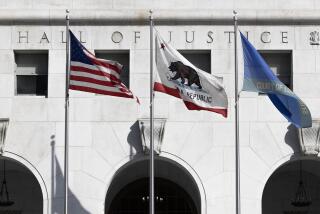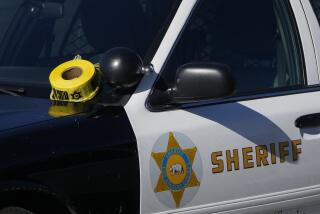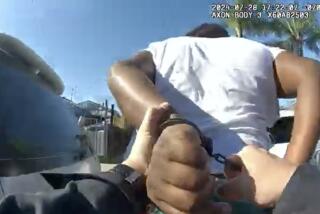Alleged Assaults by Police--a Case by Case Review
Between 1980 and mid-1991, the Special Investigations Division of the Los Angeles County district attorney’s office rejected prosecution in at least 278 cases in which law enforcement officers were suspected of assaulting civilians while on duty.
What follows is a sample of those rejections, as described in district attorney’s files examined by The Times:
Inmate Eduardo Arrellano was asleep in his jail bunk on New Year’s Eve, 1990, when Deputy Stephen A. Rumps allegedly dumped a 10-gallon container of scalding water on him after other inmates intentionally clogged the plumbing in their cells.
Arrellano suffered second-degree burns on his left thigh and right foot.
A deputy who escorted Arrellano to the jail infirmary told investigators the inmate had confided to him that the container had been knocked over and the water inadvertently splashed on him.
“The injuries he received are consistent with the scalding water being splashed on him,” Deputy Dist. Atty Terry L. White concluded. “If Deputy Rumps had deliberately thrown the water on inmate Arrellano, one would expect greater damage to Arrellano’s lower extremities.”
In 1984, Huntington Park Police Officer William J. Lustig and two other Huntington Park officers were accused of beating a businessman they mistakenly believed to be a burglary suspect. The man suffered a fractured wrist, bruises and contusions. The officers denied wrongdoing, there were no civilian witnesses and the case was rejected for prosecution.
Three years later, Lustig was accused of having unnecessarily punched a party-goer after he and other officers responded to complaints of a raucous wedding reception. Prosecutors determined that his actions “do not appear unreasonable under the circumstances.”
Within months, Lustig had again come to the attention of SID prosecutors, this time for torturing a 17-year-old car burglary suspect with an electric stun gun.
Lustig was charged, convicted and given two years in prison, the longest assault-related sentence any officer has received in recent memory in Los Angeles County.
During a traffic stop in 1984, Los Angeles Police Officer Raymond P. Conboy attempted to place Winston Wier under arrest after discovering that Wier had an outstanding traffic warrant. “An immediate and urgent personality clash developed between the two men,” Deputy Dist. Atty. Richard B. Healey would later write in his report.
Conboy allegedly struck Wier in the chest and face, causing what Healey described as “superficial injury.” The Police Department later suspended Conboy for six months without pay.
“In view of this very severe penalty,” Healey wrote, “I do not consider that a criminal prosecution is worth the expense to the public that it would of course entail.”
Three years ago, Conboy allegedly used an electronic Taser device unnecessarily on an arrestee and then handcuffed and shoved him into a wall, face first, records show. Of 11 officers at the scene, according to district attorney’s office records, some said that Conboy had used excessive force while others said that his actions were reasonable.
The SID prosecutor assigned to the case, Lawrence Mason, decided that the officers’ conflicting statements would prevent a jury from concluding beyond a reasonable doubt that Conboy had committed assault.
She was drunk and transient, with nowhere to go. But when Los Angeles police officers Ralph Alvarez and Earnest Baxley tried to check her into a downtown center for the homeless, officials there would not admit her because of “prior bad experiences.”
A few minutes later, a security guard two blocks away said he saw the woman climb out of the officers’ patrol wagon and on to the street. According to the security guard, Alvarez allegedly hit the woman once in the upper torso with a flashlight and kicked her twice.
Minutes after the officers left, a truck ran over the woman’s legs, crushing them. She died 16 days later. An autopsy attributed her death to her injuries and liver damage associated with alcoholism.
“There is insufficient (evidence) to show that the acts of the officers in leaving the victim on the street was the proximate cause of her death,” Deputy Dist. Atty. Joseph D. Shidler wrote in June. “There is nothing in the medical reports or in the coroner’s reports to corroborate the statement of the security guard that the victim was hit and kicked by the officers . . .”
Duane Bonfield was being transported to jail in 1986 on suspicion of grand theft when Deputy Victor Rodriguez stopped the patrol car. Rodriguez got out and allegedly beat Bonfield with his fists and a flashlight.
A sheriff’s lieutenant later that day saw what appeared to be bruises on Bonfield’s arms and back. The lieutenant ordered photographs taken.
Rodriguez denied wrongdoing. The deputy’s partner, after being granted immunity, appeared before the Los Angeles County Grand Jury and denied that Rodriguez had struck the suspect.
“The available evidence is not sufficient to warrant the filing of a criminal complaint,” Deputy Dist. Atty. Lawrence E. Mason wrote. “While the victim may have been struck . . . and while a lieutenant would testify that he observed what appeared to him to be fresh bruises . . . , the photos do not adequately show the injuries.”
Sean Cerceo and another man were fighting in the parking lot of a convenience store in 1985 when Los Angeles Police Officer Paul McMillin pulled in to break it up. In the ensuing scuffle with the officer, Cerceo lost four teeth.
Other officers at the scene alleged that Cerceo kicked McMillin in the groin, then McMillin attempted to strike the suspect in the chest with his baton but missed and hit him in the mouth.
Cerceo alleged that McMillin intentionally swung at his face while other officers held his arms.
After reviewing the Police Department’s 85-page report on the incident, Deputy Dist. Atty. James E. Koller wrote, “We cannot say that Officer McMillin’s conduct was criminal beyond a reasonable doubt.”
More to Read
Sign up for Essential California
The most important California stories and recommendations in your inbox every morning.
You may occasionally receive promotional content from the Los Angeles Times.









